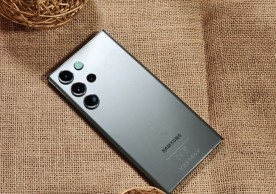Sony Xperia Ion vs HTC One X vs Samsung Galaxy Note LTE: Which AT&T 4G LTE Phone is for You?
Akansha Srivastava
Like all other major smartphone vendors, Sony has also managed to launch its latest LTE offering in the U.S. consumer market. Yes, Sony Xperia Ion, the 4G LTE capable smartphone, which the Japanese giant introduced at Consumer Electronics Show (CES) 2012, is finally out on the retail shelves of the country from June 25. Sony Xperia Ion, the first US-branded LTE smartphone from the Japanese electronics major for the U.S. consumer (after its split with Ericsson) is available exclusively on AT&T at a price tag of $99.99 with a new two-year agreement. The new budget phone is also available at Sony and Best Buy retail and online stores.
While Xperia Ion marks Sony's 4G LTE foray with AT&T, HTC and Samsung are no newcomers to the wireless carrier - the HTC One X is available for Android fans on AT&T at $199.99 and the Korean tech giant's phablet Galaxy Note LTE is available for around $249, both on 2-year contract.
If you are going for a phone upgrade and are confused, here is a brief comparison to give an idea on which one suits you the best.
Form Factor
Sony Xperia Ion, the glossy black monolithic smartphone is handsomely styled. The phone displays a dimension of 133 x 68 x 1.8 mm and weighs around 144 grams. On the other hand, HTC One X boasts a candybar look and measures134.8 x 69.9 x 8.9mm in thickness and weighs approximately 130 grams. Whereas the Galaxy Note is a big phablet, measuring 146.8 x 83 x 9.7mm and weighing 178 grams.
Sony Xperia Ion will be sporting a 4.65-inch Mobile BRAVIA engine HD touchscreen display with 1280 X 720 pixels resolution and features like multi touch, timescape, accelerometer sensor for auto-rotate and ambient light sensor. In comparison, HTC One X features a vivid 4.7-inch Super LCD 2 capacitive touchscreen. The resolution of the display is 720 x 1280 pixels with a pixel density of 313 pixels per inch (ppi).
As for the Galaxy Note, the Samsung phablet features a massive 5.3-inch Super AMOLED capacitive touchscreen with the advantage of Corning Gorilla Glass, the TouchWiz User Interface (UI) and a resolution of 800 x 1280 pixels with a pixel density of 285 ppi. The Note also features a stylus - S Pen, which allows users to write on the 5.3-inch screen as if the Note were a pad of paper.
Operating System
The Xperia Ion does not run Android 4.0 Ice Cream Sandwich out of the box. Buyers will get the smartphone running Android 2.3 Gingerbread. However, Sony has confirmed that the ICS update will reach the device soon.
Similar to Xperia Ion, Samsung Galaxy Note LTE also still runs on the Android OS 2.3 (Gingerbread) out of the box, but Samsung has announced an update to Android 4.0 ICS (which can happen any time).
The HTC One X runs on the Android 4.0.
Processor
Sony Xperia Ion is powered by the 1.5GHz Snapdragon S3 dual-core processor, which has become rather outdated now.
Talking about HTC's offering, the global version of One X is powered by NVIDIA Tegra 3 chipset with quad-core 1.5 GHz whereas the LTE version of the One X on AT&T is powered by Qualcomm Snapdragon S4 MSM 8960 dual-core processor clocked at 1.5GHz.
The Galaxy Note is powered by a Qualcomm MSM8660 Snapdragon chip with a dual-core 1.5GHz Scorpion processor. All three smartphones pack 1GB of RAM.
Camera
In this section, Sony Xperia Ion scores big, as the smartphone is fitted with a beefy 12-megapixel auto-focus camera with an LED flash and Exmor R sensor and geo-tagging, touch focus, face and smile detection, 3D sweep panorama and image stabilization features. In comparison, HTC One X packs 8-megapixel auto-focus camera with LED flash along with other features such as simultaneous HD video and image recording, geo-tagging, and face and smile detection. Samsung's offering also boasts of 8-megapixel auto-focus camera with LED flash and geo-tagging, touch focus, face and smile detection, and image stabilization features.
However, when it comes to secondary camera, it's a different story. Galaxy LTE Note has a better secondary camera of 2-megapixel, which can record video in 720p, whereas Sony Xperia Ion and HTC One X feature the same 1-megapixel front-facing camera, though they are also capable of shooting 720p videos.
Connectivity
All the three smarphones are 4G LTE capable and feature the latest Near Field Communication (NFC) technology. Sony Xperia Ion supports micro USB 2.0, 3.5mm headset jack, FM radio, 802.11 Wi-Fi b/g/n and Bluetooth 3.0.
The HTC One X offers 802.11 a/b/g/n and Bluetooth version 4.0, while Galaxy Note supports Wi-Fi 802.11 a/b/g/n, DLNA, Wi-Fi Direct, Wi-Fi hotspot and Bluetooth v3.0 with A2DP and EDR.
Storage
In this section, all the three smartphones come with an internal storage option of 16GB. However, the HTC One X does not support microSD card, while Sony Xperia Ion and Samsung Galaxy Note both offer microSD card slot for expansion up to 32GB.
Battery
Sony Xperia Ion is loaded with Li-Ion 1900 mAh battery, with which the smartphone will offer up to maximum 10 hours of talk time, while HTC One X is powered by Li-ion 1800mAh battery delivering talk time for more than 8 hours.
However, Samsung Galaxy Note runs on the most powerful battery out of three - the 2500mAh Li-Ion battery delivers talk time of up to 12 hours. The battery of Galaxy Note is also user replaceable.
Verdict
As far as budget phone is concerned, Sony Experia Ion takes the cake. However, HTC One X has already got rave reviews from the tech experts for its outstanding performance and features. And, if you fancy a stylus and loves to work on a massive screen, then Samsung Galaxy Note LTE is the best option for you, though we must warn that the smartphone is really bulky and huge.
most read
more stories from Mobile
-
The MIAD 01: Audiophile Brand Moondrop Teases Its First Smartphone
Moondrop, known for audiophile gear, teases its inaugural smartphone, the MIAD 01, promising a unique blend of audio excellence and mobile technology.
ernest hamilton -
Android 15 Could Simplify Notification Channels, Hide Unused Ones
Android 15 aims to streamline notification channels by hiding unused ones, enhancing user experience and decluttering notification settings.
ernest hamilton -
DolphiniOS Reveals Why GameCube and Wii Emulator Won't Be Available in App Store
DolphiniOS developers shed light on why the GameCube and Wii emulator won't be available in the App Store.
ernest hamilton -
Free Screen Replacement Offered to Galaxy S21 and S22 Owners in India Facing Green Line Issue
Get your screen fixed! Galaxy S21 and S22 owners in India facing the green line issue can now enjoy free screen replacements. Don't miss out on this offer!
ernest hamilton -
Second April Update for Pixel Phones Addresses Widespread Network Issue
Stay updated! The second April update for Pixel phones resolves a widespread network issue. Read more to ensure your device stays connected.
ernest hamilton -
iOS 18: Gurman Reveals On-Device LLM Powering AI Features, Offering Privacy and Speed Benefits
Stay ahead of the curve with Gurman's insights into iOS 18's groundbreaking features. Learn how on-device LLM empowers AI with privacy and speed benefits!
ernest hamilton -
Galaxy Phone Screens Displaying Green Line Issue Post April 2024 Update
Troubled by green lines on your Galaxy phone after the April 2024 update? Learn how to address this screen issue.
ernest hamilton -
Google Drive's New Search Filters Now Available on Android Following iOS Release
Discover the power of Google Drive's new search filters on Android! Enhance your productivity today.
ernest hamilton












